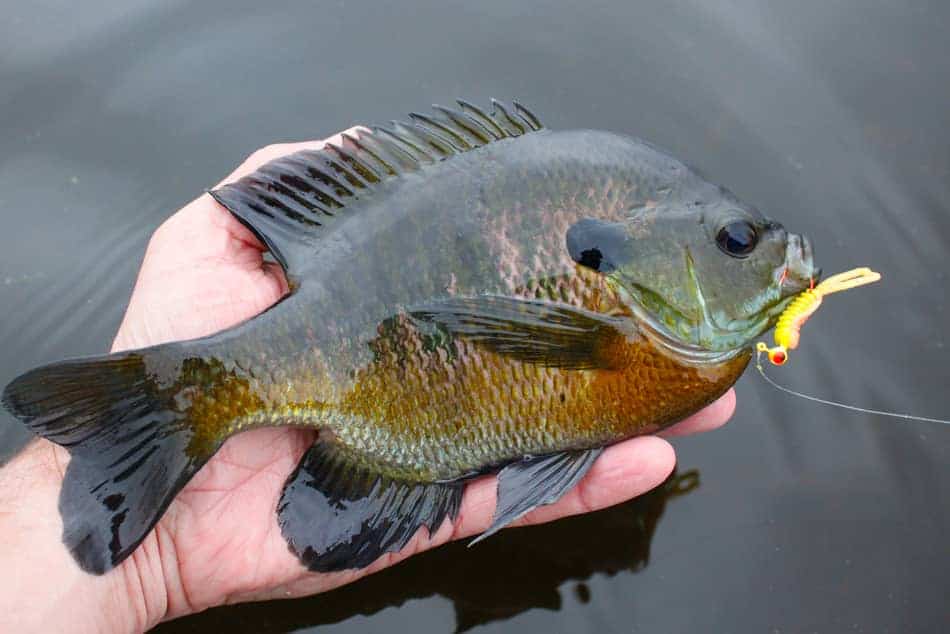
Catching Bluegill is a favorite pastime for many anglers around the world. Bluegill fishing is easy and fun, making it a great fishing adventure for the entire family.
How To Catch Bluegill
Bluegill are caught fishing freshwater structures in lakes, rivers, and creeks using both live bait & artificial lures on light tackle. When fishing artificial, Bluegill prefer a slow to moderate retrieval.
Bluegill are caught using various fishing techniques throughout different seasons.
In the Spring, female Bluegill move into shallow waters ranging from 12” to 36” where they create nests and lay their eggs along the shoreline. When Bluegill are “nesting”, they can be easily caught by casting on or adjacent to their nest and slowly dragging the lure/bait, pausing the moment it is inside the nest. Once it’s inside the fish’s nest, they quickly grab it and move it out of the nest. As soon as the Bluegill grabs the bait, promptly set the hook.
In Winter, Bluegill move into deeper water ranging from 5’ to 20’ in-depth in search of waters with constant temperatures. Since the water temperatures are low in winter, it is essential to slow down your lure presentation. Many fish become lethargic during the winter months, so it is essential to adjust your fishing strategies to accommodate their new eating habits.
One way to increase your Bluegill fishing success in winter is fishing live baits. Live baits, unlike artificial lures, do not require a retrieval to attract fish; you can simply cast your bait into your fishing spot and wait for the Bluegill to come out and devour it at their own pace.
Bluegill are known to congregate around submerged structures, so you can easily increase your fishing productivity by fishing submerged branches, logs, and other artificial structures.
When fishing live bait, it is recommended that you use a bobber. Fishing with a bobber allows you to adjust the bait presentation for the depth you are fishing. If you are fishing with a depth finder or know the approximate depth of the lake you are fishing, you can adjust the bobbers distance from the hook allowing you to fish a specific region in the water column. Bluegill prefer a bait presentation on the lower third of the water column. To give an example of this, say you are fishing in 6’ of water, you would want to adjust your bobber to be 4’ above your hook, allowing your bait to hover two feet above the lake bottom.
Expert Tips On Catching Bluegill
- Live bait is best: Though there are so many great fishing lures for Bluegill, you will almost always catch more fish when fishing live bait. The key is knowing what is going to be the best bait for your area. An excellent way to figure this out is to see what they are naturally preying on in your area, such as crickets, worms, etc. and matching that.
- Keep your distance: Bluegill can be extremely skittish, so try to keep your distance from the spot you are fishing by making a long cast.
- Bring your polarized glasses: Bluegill are often caught sight fishing, so bring your polarized glasses to help locate them.
- Fish the Shallows: Though Bluegill tend to head out to deeper water in the winter, they are still predominantly caught fishing water depths ranging from 12” to 36”.
- Find the structure: Bluegill are known to congregate heavily around submerged structures for protection from other predator fish as well as camouflage that allows them to prey on passing by insects and baitfish.
- Don’t fish the heavy current: Bluegill are rarely caught in areas with heavy current. Bluegill prefer slow to no current at all. If you are fishing a creek or river with current, the best place to catch them will be small pools of water off to the side of the river with slow-moving water.
When Can You Catch Bluegill?
Bluegill are caught year-round but are most prevalent during Spring when they are spawning in shallow waters.
Where Can You Catch Bluegill?
Bluegill are caught in freshwater lakes, rivers, & creeks in various depths but prefer depths ranging from 12” to 36”. During different seasons they are caught fishing in different areas. In winter, Bluegill head into deeper water, and in summer & spring, they prefer the shallows.
Best Fishing Tackle For Catching Bluegill
The best fishing tackle for catching Bluegill is a small micro fishing setup.
When it comes to catching Bluegill, a light fishing rod with a length ranging from 6’ to 7’ is optimal.
Since Bluegill are not aggressive fighters, it is recommended to use a small reel to increase the overall sport of catching these small fish. I do not recommend exceeding a 2000 sized reel.
Best Fishing Line For Catching Bluegill
The best fishing line for catching Bluegill is a 4lb to 6lb monofilament. If you choose to spool your reel with a braid, it is essential that you use a fluorocarbon leader because Bluegill have great eyesight and can become suspicious of your bait if they can see the line.
Best Hook Size For Catching Bluegill
The best hook size for catching Bluegill is a 6 or smaller. Bluegill have extremely small mouths, so it is essential to use small hooks for optimal hookups.
What Are Bluegill?
Lepomis Macrochirus commonly referred to as Bluegill by the fishing community, is in the sunfish family. Bluegill received their name because of the blue dot-like structure that grows on the end of their gill plates. Bluegill are also characterized by their dark greenbacks that slowly fade to grey towards their bellies. Bluegill are small gamefish that are targeted by many anglers but rarely exceed 12” in length.
Natural Bluegill Diet
- Worms
- Crickets
- Shrimp
- Crayfish
- Baitfish (various species)
- Mosquito larvae
- Zooplankton
Are Bluegill Good To Eat?
Bluegill are excellent to eat. The meat is firm and flaky with a mild flavor profile that makes them popular table fare.
Are Bluegill And Bass In The Same Family?
Bluegill and bass are both in the Centrarchidae family, making them close freshwater relatives.
Are Bluegill Toxic?
Bluegill have no known toxins making them safe for human consumption.
Do Bluegill Have Scales?
Bluegill have scales that start from their gill plate and end at the base of their tail. Bluegill scales are small, often measuring less than a 1/10th of an inch in diameter.
Do Bluegill Have Teeth?
Bluegill have small canonical teeth on both their top and bottom jaws. The teeth are microscopic, often feeling like sandpaper when lipped by anglers.
How Many Bluegill Can You Keep?
The amount of Bluegill you can keep is dependent on where you are targeting the fish. In Florida, you can harvest 50 Bluegill, whereas in Mississippi, you can keep up to 100.
